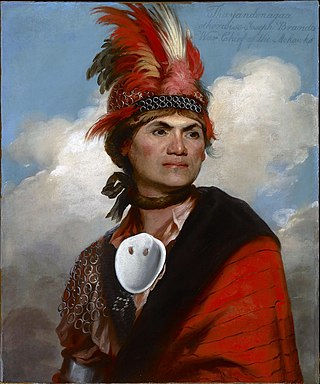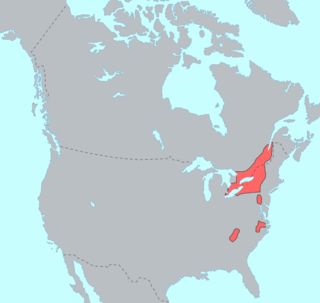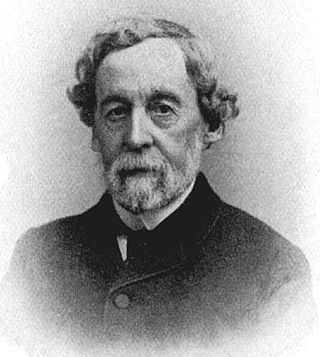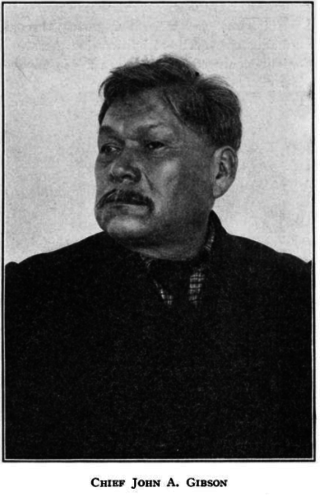Career
Starna and fellow archeologist Dean R. Snow conducted an extended project beginning in 1982 involving archeological excavations along the Mohawk Valley and its river, referred to as the Mohawk Valley Project. The project was conceived in 1980 during discussions between Starna and Snow. Starna, who grew up among the modern indigenous inhabitants and who introduced Snow to the valley, provided valuable archeological assistance to Snow during the first two projects, proving crucial to the project's long-term success, which lasted thirteen years. By 1989 Starna and Snow developed methods by which enabled them to determine Mohawk Indian population size for any specific year with "unexpected accuracy". [4]
Other fields Starna has studied and written about include Epistemology, i.e.the relationship between existing knowledge and philosophy, and the models used in this field, while asserting that there is no general consensus on what constitutes a model, as their application is greatly varied, maintaining that it is best to describe models in terms of their function. [5] Starna has written several technical reports on Native American history and culture for Indian tribes, universities and museums. In 1986 he received a Nelson A. Rockefeller Institute of Government Senior Fellowship award to assist him in the effort in studying Iroquois land claims in upstate New York [6] involving the allegedly illegal transfer of much of Iroquois land that occurred between the 1760s and the 1840s. [7]
In 2014 Starna noted various errors in New York State Education Department's (YNSED) Social Studies Framework and their Toolkit Development Project, involving interpretations and facts about colonial and American Indian history. In February the next year Starna met with a NYSED staff member to discuss the various discrepancies, following with an extended email correspondence. At first there was cooperation between NYSED and Starna, however, according to Starna, indifferences emerged, where he later wondered if there were political factors influencing their discussions and lack of cooperation. Starna concluded that, "Neither the state's teachers nor its students are well served by such an inattentive approach to education, Common Core Standards not withstanding". [2]
On April 19, 2018, Starna delivered a lecture at the Jacob Leisler Institute, in Hudson, New York, on the Iroquoian and Algonquian Indian nations of Eastern North America with focus on their culture and society. [8] Starna has also conducted lectures, and held adjunct appointments at the State University on New York at Albany, Binghamton University, and Queen’s University at Kingston, Ontario. [9]
Starna was elected vice president of the board of trustees of the Jacob Leisler Institute for the Study of Early New York History in 2020. [10] He is a Fellow of the New York Academy of History and serves on the board of the Jacob Leisler Institute for the Study of Early New York History. He was a consultant with the Native American Rights Fund. [3]

Among the Haudenosaunee the Great Law of Peace, also known as Gayanashagowa, is the oral constitution of the Iroquois Confederacy. The law was written on wampum belts, conceived by Dekanawidah, known as the Great Peacemaker, and his spokesman Hiawatha. The original five member nations ratified this constitution near modern-day Victor, New York, with the sixth nation being added in 1722.

The Mohawk people are the most easterly section of the Haudenosaunee, or Iroquois Confederacy. They are an Iroquoian-speaking Indigenous people of North America, with communities in southeastern Canada and northern New York State, primarily around Lake Ontario and the St. Lawrence River. As one of the five original members of the Iroquois League, the Mohawk are known as the Keepers of the Eastern Door – the traditional guardians of the Iroquois Confederation against invasions from the east.

Samuel Kirkland was a Presbyterian minister and missionary among the Oneida and Tuscarora peoples of present-day central New York State. He was a long-time friend of the Oneida chief Skenandoa.

The Iroquoian languages are a language family of indigenous peoples of North America. They are known for their general lack of labial consonants. The Iroquoian languages are polysynthetic and head-marking.

Leisler's Rebellion was an uprising in late-17th century colonial New York in which German American merchant and militia captain Jacob Leisler seized control of the southern portion of the colony and ruled it from 1689 to 1691. The uprising took place in the aftermath of England's Glorious Revolution and the 1689 Boston revolt in the Dominion of New England, which had included New York. The rebellion reflected colonial resentment against the policies of deposed King James II.

The Algonquians are one of the most populous and widespread North American native language groups. They historically were prominent along the Atlantic Coast and in the interior regions along Saint Lawrence River and around the Great Lakes. This grouping consists of the peoples who speak Algonquian languages.

Horatio Emmons Hale was an American-Canadian ethnologist, philologist and businessman. He is known for his study of languages as a key for classifying ancient peoples and being able to trace their migrations.
The Great Peacemaker, sometimes referred to as Deganawida or Tekanawí:ta was by tradition, along with Jigonhsasee and Hiawatha, the founder of the Haudenosaunee, commonly called the Iroquois Confederacy. This is a political and cultural union of six Iroquoian-speaking Native American tribes governing parts of the present-day state of New York, northern Pennsylvania, and the eastern portion of the provinces of Ontario, and Quebec Canada, recognized as sovereign by both the USA and Canada.
William N. Fenton was an American scholar and writer known for his extensive studies of Iroquois history and culture. He started his studies of the Iroquois in the 1930s and published a number of significant works over the following decades. His final work was published in 2002. During his career, Fenton was director of the New York State Museum and a professor of anthropology at the State University of New York.

The Two Row Wampum Treaty, also known as Guswenta or Kaswentha and as the Tawagonshi Agreement of 1613 or the Tawagonshi Treaty, is a mutual treaty agreement, made in 1613 between representatives of the Five Nations of the Haudenosaunee and representatives of the Dutch government in what is now upstate New York. The agreement is considered by the Haudenosaunee to be the basis of all of their subsequent treaties with European and North American governments, and the citizens of those nations, including the Covenant Chain treaty with the British in 1677 and the Treaty of Canandaigua with the United States in 1794.

Laurentian, or St. Lawrence Iroquoian, was an Iroquoian language spoken until the late 16th century along the shores of the Saint Lawrence River in present-day Quebec and Ontario, Canada. It is believed to have disappeared with the extinction of the St. Lawrence Iroquoians, likely as a result of warfare by the more powerful Mohawk from the Haudenosaunee or Iroquois Confederacy to the south, in present-day New York state of the United States.

The Schenectady massacre was an attack against the colonial settlement of Schenectady in the English Province of New York on February 8, 1690. A raiding party of 114 French soldiers and militiamen, accompanied by 96 allied Mohawk and Algonquin warriors, attacked the unguarded community, destroying most of the homes, and killing or capturing most of its inhabitants. Sixty residents were killed, including 11 Black slaves. About 60 residents were spared, including 20 Mohawk.

The Iroquois, also known as the Five Nations, and later as the Six Nations from 1722 onwards; alternatively referred to by the endonym Haudenosaunee are an Iroquoian-speaking confederacy of Native Americans and First Nations peoples in northeast North America. They were known by the French during the colonial years as the Iroquois League, and later as the Iroquois Confederacy, while the English simply called them the "Five Nations". The peoples of the Iroquois included the Mohawk, Oneida, Onondaga, Cayuga, and Seneca. After 1722, the Iroquoian-speaking Tuscarora people from the southeast were accepted into the confederacy, from which point it was known as the "Six Nations".
Canassatego was a leader of the Onondaga nation who became a prominent diplomat and spokesman of the Iroquois Confederacy in the 1740s. He was involved in several controversial land sales to colonial British officials. He is now best known for a speech he gave at the 1744 Treaty of Lancaster, where he recommended that the British colonies emulate the Iroquois by forming a confederacy. He was reportedly assassinated, perhaps by sympathizers or agents of New France.

Johannes Megapolensis (1603–1670) was a dominie (pastor) of the Dutch Reformed Church in the Dutch colony of New Netherland, beginning in 1642. Serving for several years at Fort Orange on the upper Hudson River, he is credited with being the first Protestant missionary to the Indians in North America. He later served as a minister in Fort Amsterdam on Manhattan Island, staying through the takeover by the English in 1664.

John Arthur Gibson (1850–1912) was a chief of the Seneca nation of the North American Iroquois confederation. Part Onondaga and part Seneca, he resided within the reserve of the Six Nations of the Grand River in Ontario, Canada. Knowledgeable about Iroquois (Haudosaunee) culture, he is best known for the versions he provided of the Iroquois oral constitution, the Great Law of Peace. He acted as an advisor to the Canadian Department of Indian Affairs in matters relating both to Iroquois and non-Iroquois indigenous people. He was a well-respected player of the traditional Iroquois sport of lacrosse until he was blinded during a game when he was 31.

The Iroquoian peoples are an ethnolinguistic group of peoples from eastern North America. Their traditional territories, often referred to by scholars as Iroquoia, stretch from the mouth of the St. Lawrence River in the north, to modern-day North Carolina in the south.
Elisabeth Jane Tooker was an American anthropologist and a leading historian on the Iroquois nations in north-eastern United States.
Dean Richard Snow is an archeologist and an American historian who is Professor Emeritus of Anthropology at Pennsylvania State University who has conducted extensive archeological research on the Iroquois Indian nations of north-eastern America, and other indigenous peoples in the highlands of Mexico, and in Spain and France. Snow specializes in Ethnohistory and is considered an authority in this field. Snow has conducted archaeological field investigations along the Mohawk Valley and at the Saratoga battlefield. In 1977 he was asked by the U.S. Department of Justice to act as a historical consultant involving Indian land claims against the state of Maine. Snow was raised in Sleepy Eye, Minnesota. He married Janet Keller in 1963. They and their three adult children all live in the Saratoga region in upstate New York. Snow has written many books and journal articles on North-American archeology, Indian nations and related subjects.
Harmen Meyndertsz van den Bogaert was an early Dutch settler in New Netherland, explorer, and barber surgeon. Van den Bogaert's personal journal from his expedition into Iroquois country, A Journey into Mohawk and Oneida Country, 1634-1635, is the first written description of the Mohawk Valley and among the first ethnographical accounts of the Iroquois people and the Mohawk language. He is also notable for being among the first known people in the Americas to be killed as a result of their homosexuality.











